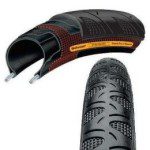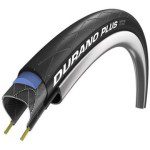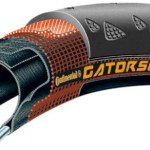We hate to say it but it’s time to start thinking about setting up the bike for the autumn season and that should start with tyres.
The amount of abuse tyres take in the off season should not be underestimated. Road surfaces deteriorate at an alarming rate, huge amounts of debris get washed on to them and that’s before the ice and snow arrives to take away grip. Tyres therefore have a lot more to cope with than the summer needs of just weight and traction.
Autumn rides also tend to be longer and more leisurely meaning more time on the bike so the correct tyre choice can make this more enjoyable or at least help it pass without incident.
The ultimate tyre would be a combination of grip, puncture resistance and comfort but in the real world it’s just too difficult to achieve all this and have a tyre you can use for long distances so they tend to be a mix of each.
Thankfully there’s a wide and growing range of winter specific tyres available with different levels of each key factor depending on your needs.
Grip
Anyone who has experienced a loss of grip will know that dreaded felling when the tyres start to go and there’s nothing you can do. Grip therefore would be a number one priority for most in winter tyres and depends on several factors.
 It’s not just tread that influences grip levels, although that is the obvious one, but compound as well. No point in going for a slick, low rolling resistance tread when roads are covered in water or ice so look for tread patterns that will allow water to run off and provide a bit of traction at least.
It’s not just tread that influences grip levels, although that is the obvious one, but compound as well. No point in going for a slick, low rolling resistance tread when roads are covered in water or ice so look for tread patterns that will allow water to run off and provide a bit of traction at least.
It’s worth bearing in mind that a deep tread will increase rolling resistance and will feel different from lightweight summer versions.
Rubber compound is more of factor but don’t go for something too soft or it will pick up every piece of debris such as flints and thorns and more than likely cause a puncture. A tyre which has a good mix of both characteristics will serve you well.
Puncture resistance
 There’s nothing worse than puncturing on a cold or wet ride and let’s face it when it usually happens it’s both!
There’s nothing worse than puncturing on a cold or wet ride and let’s face it when it usually happens it’s both!
Each manufacturer has their own version of puncture protection built in to their tyres which can go a long way in helping to avoid punctures. A strip between the outer tread and inner carcass will strengthen and protect the tyre but there is a slight weight penalty.
Side walls are also an area that are usually strengthened in autumn tyres to help protect against pinch flats, usually when hitting potholes, and generally adding more protection to the tyre carcass.
This stiffening of the sidewalls changes the feel of the tyres and can affect handling so it is recommended to take time to learn the limits of new tyres before going full speed into corners.
Width
The width of the tyre can affect several things; grip, puncture resistance, rolling resistance and comfort. Autumn tyres therefore tend be wider than fair weather versions for several reasons.
 A wider tyre increases the contact area with the road which increases grip and can also be run at slightly lower pressures to allow for even more grip. The larger air volume allows the tyre to deflect more offering more protection against pinch punctures.
A wider tyre increases the contact area with the road which increases grip and can also be run at slightly lower pressures to allow for even more grip. The larger air volume allows the tyre to deflect more offering more protection against pinch punctures.
The larger air volume also offers increased levels of comfort as there’s more air to cushion the wheel against the road. As with most things in cycling though there is one drawback with wider tyres in that they increase rolling resistance making the bike harder to push and sometimes making handling sluggish.
Most bikes are fitted with a 23mm tyre as standard so a 25mm is recommended for winter, or even a 28mm, but remember to make sure there is sufficient clearance between tyre and frame (don’t forget mudguards if fitted) to run wider tyres.
Top tips
- Check tyres after each ride for cuts or embedded stones or thorns.
- Ensure tyres are inflated to the correct pressure for road and weather conditions.
- Check brake blocks are hitting the rim properly and not rubbing on sidewalls.
- If you puncture more than three times in a short space of time with the same tyre get a new one.
